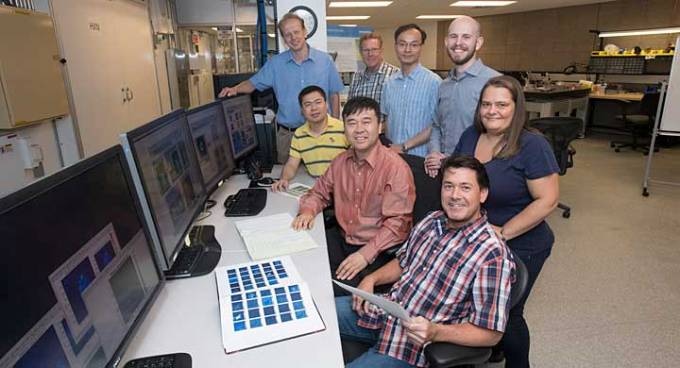Jul 27 2016
Scientists at the U.S. Department of Energy's Brookhaven National Laboratory are proud recipients of one of the 2016 Microscopy Today Innovation Awards, which highlight the 10 best microscopy innovations each year. The team at the Hard X-ray Nanoprobe (HXN) beamline at the National Synchrotron Light Source II (NSLS-II), a U.S. Department of Energy User Facility, collaborated with Argonne National Lab to develop a hard x-ray scanning microscope in use at the HXN beamline today. They received the award at the Microscopy Today Innovation Award ceremony held Wednesday, July 27 at the Microscopy & Microanalysis 2016 meeting in Columbus, Ohio.
 The beamline team at the Hard X-ray Nanoprobe (HXN) beamline at the National Synchrotron Light Source II, including physicists Yong Chu, Evgeny Nazaretski, and Hanfei Yan; associate physicists Nathalie Bouet and Xiaojing Huang; senior design engineer Brian Mullany, senior technical specialist Dennis Kuhne, and software analyst Kenneth Lauer.(Credit: Brookhaven National Laboratory)
The beamline team at the Hard X-ray Nanoprobe (HXN) beamline at the National Synchrotron Light Source II, including physicists Yong Chu, Evgeny Nazaretski, and Hanfei Yan; associate physicists Nathalie Bouet and Xiaojing Huang; senior design engineer Brian Mullany, senior technical specialist Dennis Kuhne, and software analyst Kenneth Lauer.(Credit: Brookhaven National Laboratory)
"The HXN microscope is a jewel in the crown of NSLS-II," said John Hill, NSLS-II Director. "It provides world-leading resolution for our users and, amazingly, did so from the moment it turned on. That kind of advance is only possible after years of intense hard work by experts who are world-leaders in their respective fields working closely together. I am delighted that their work has been recognized by this award and very proud to have this microscope at NSLS-II."
The microscope manipulates novel nanofocusing optics called multilayer Laue lenses (MLL) — incredibly precise lenses grown one atomic layer at a time — which produce a tiny x-ray beam that results in 12 by 13 nanometer spatial resolution. Achieving this resolution requires precise alignment of two MLL optics and control of thermal drifts and vibrations to within a few nanometers.
Focusing an x-ray beam to that level means being able to see the structures on that length scale, whether they are hierarchical nanostructures of functional materials and biological systems, or the inner workings of a battery cell. The nanoprobe is an extremely versatile tool that is well-suited to experiments in many fields of science.
"This is the first MLL-based microscope, and it's the first time this resolution has been readily available for users," said Evgeny Nazaretski, a physicist at NSLS-II who spearheaded the development of the microscope.
"Our MLL x-ray microscope opened up new scientific frontiers of high-resolution x-ray imaging, taking full advantage of the brightness of NSLS-II and the high-stability infrastructure of the HXN beamline," said Yong Chu, the lead scientist of the Nanoprobe beamline.
HXN offers researchers the capability to do x-ray fluorescence, diffraction, ptychography, spectroscopy, and tomography with unprecedented resolution and sensitivity. Hanfei Yan, a member of the development team added, "Using this unique instrument, the nanoprobe users will be able to perform in operando studies and gain fundamental understanding of how nanostructures evolve during complex reactions, leading to optimization of a material's functionality."
The development team includes Brookhaven scientists, engineers, and technical staff Evgeny Nazaretski, Yong Chu, Kenneth Lauer, Hanfei Yan, Brian Mullany, Nathalie Bouet, Juan Zhou, Dennis Kuhne and Argonne senior engineer Deming Shu.
The HXN beamline was built as part the NSLS-II construction project, funded by DOE's Office of Science.
Source: https://www.bnl.gov/